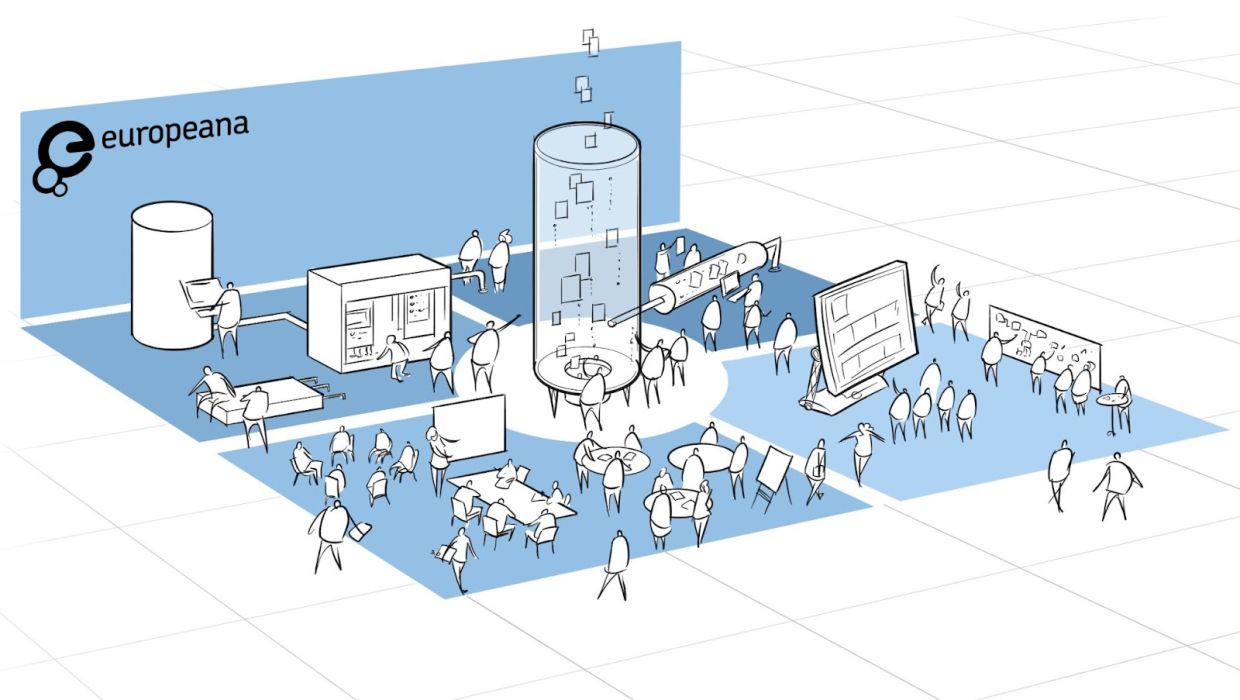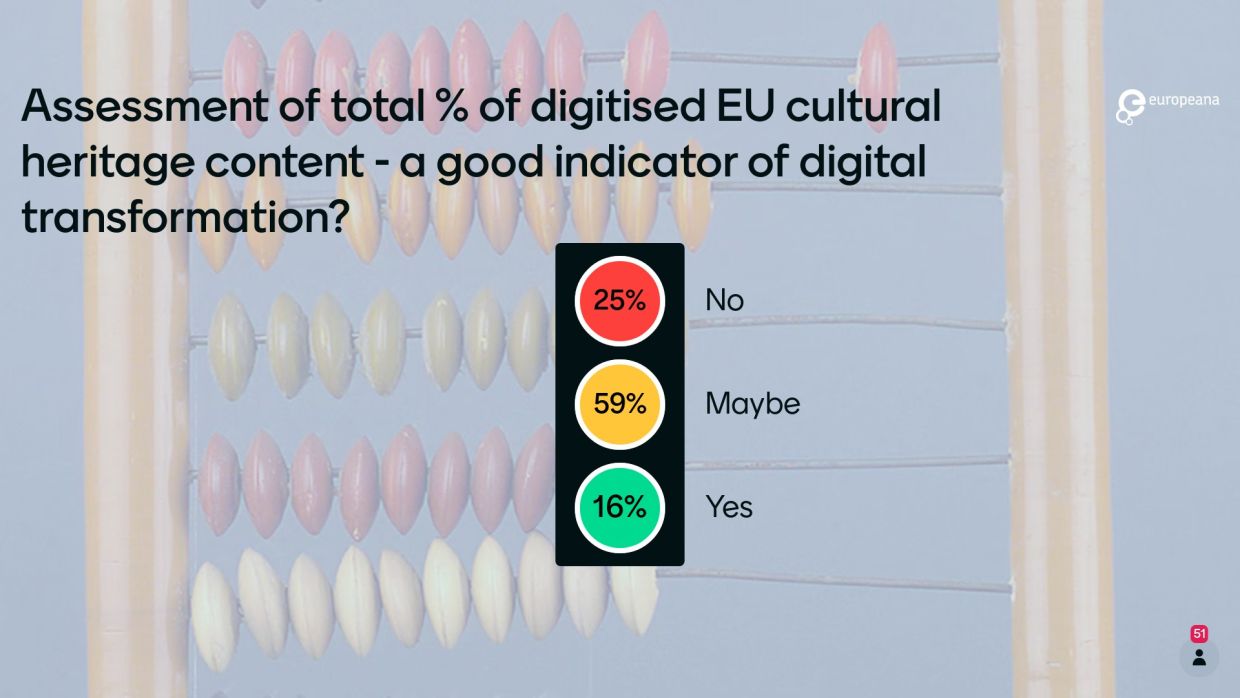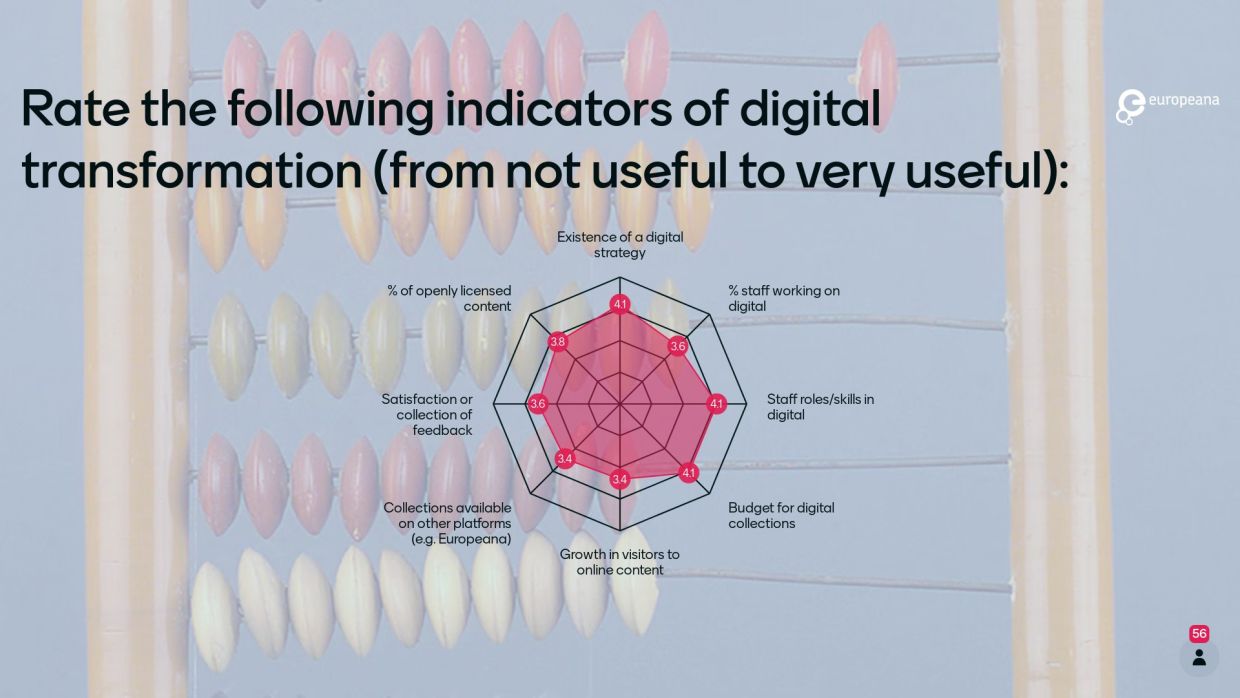Report from the Czech Presidency Europeana conference
Read the report ‘Digital transformation in the common European data space for cultural heritage: measurement and assessment, Czech Presidency 2022’ below.
Read the report ‘Digital transformation in the common European data space for cultural heritage: measurement and assessment, Czech Presidency 2022’ below.
In November 2022, under the Czech Presidency and in collaboration with the Czech National Heritage Institute, the Europeana Foundation invited the Expert Group on a common European Data Space for Cultural Heritage and international experts to discuss how data is helping us, or could better help us, to paint the picture of the digital transformation of the cultural heritage sector in the data space. We discussed the importance of good, open and interoperable data, particularly around reuse; how self-assessment can help us improve digital strategies and organisational practices; and how more holistic indicators might help us not only monitor progress but also design for more impact, helping heritage institutions to improve the lives and wellbeing of Europe’s citizens.
Digital transformation is a key element in the data spaces initiative, which aims to create ‘a genuine single market for data, open to data from across the world’ (A European Strategy for data, 2022). We want to be able to use more holistic data collected about digital cultural heritage and its reuse to paint the current picture of the digital transformation of the sector. In doing so, we gain insight into what issues our sector faces and how these might be addressed in and through the data space. This ‘baseline’ will also help us measure and assess progress - and our impact - as we move into the cultural heritage data space. Key to this are participatory, or bottom-up, methodologies where digitisation activities are planned with, by, and for the communities who have a vested interest in their existence and reuse. We discussed various data gathering activities taking place throughout Europe and internationally, the positive outcomes they generated, and how data gathering can help support participatory practices and the digital transformation process.

Introduction
Introduction and welcome by Hannah Baker Hitzhusen, Europeana Foundation
‘The importance of openness’ by Ondrej Profant, Deputy Minister for Digitisation, the Ministry of Regional Development
‘Year 2025: where is the data’ by Rehana Schwinninger-Ladak, DG CONNECT, European Commission
‘We can’t have a data space without the data: Setting the scene’ by Harry Verwayen, Europeana Foundation
Lightning talks (five minutes each)
Pille Pruulmann Vengerfeldt, Malmö University
Frederik Truyen, KU Leuven
Kristīne Pabērza-Ramiresa, IFLA Library Map of the World
Panel discussion
Moderated by Fiona Mowat and Nicole McNeilly, Europeana Foundation
Speakers:
Katerina Moutogianni, DG CONNECT, European Commission
Olga Tykhonova, MUSEUM BOOSTER and DOORS project
Naďa Machková Prajzová, Muse Impact
Agata Krawczyk, Ministry of Culture and National Heritage, Poland
Closing
Hannah Baker Hitzhusen and Harry Verwayen (Europeana Foundation), with an invitation to the Swedish Presidency of the EU by Eva Stengård, Ministry of Culture, Government Offices of Sweden.
The Europeana Initiative began to deploy and steward the common European data space for cultural heritage from September 2022, with an aim to improve digital service infrastructure in this sector, to help cultural institutions improve and expand their digital collections, and reach their audiences effectively. To make this happen we need data in the data space, and not only the data that make up the digital collections themselves, like the metadata (data about digital collections), but also:
Survey data (data directly from those delivering digital transformation, including digital collections, and users and beneficiaries);
Auxiliary data (data from secondary sources about the cultural sector and its audiences, e.g. economic data and national datasets);
Paradata (e.g. data about how digital collections were created, or data about how surveys were run); and
Passive data (such as digital activity/behavioural data that show us how collections are being used/re-used).
We already know why the data are important. Data gathered from cultural organisations about their current practices in digitisation and digital collections work can help us to measure and assess where capacity building activities might be targeted, or where potential sources of untapped data lie. Data collected on types of digital objects and digitisation can inform new strategies and help us track progress.
For example, in the coming years of the data space, there will be a strong focus on increasing the number of 3D digital collections items available through the Europeana website. Success in this area depends on various factors such as the uptake of 3D digitisation in the sector and the availability of 3D digital collections. Data we collect from audiences can tell us what kind of 3D objects people need and how they might use them, as well as helping us to assess their impact. In the upcoming conference under the Swedish presidency, on accelerating 3D in the common European data space for cultural heritage: why 3D matters?, this theme will be explored in more detail.
The existence and quantity of digital collections have long been considered a major indicator of the digital transformation of the sector. But what other indicators are there, and how can we better understand the impact of our actions?

Measurements like the total percentage of digitised collections do not reflect the impact of those collections and how they are being, or can be, reused. In the data space, we need to better demonstrate the connection between digital culture, reuse, and community participation.

The discussion at the symposium highlighted current challenges around collecting data. This includes, for example, the difficulty of sharing data between organisations or Member States, or a lack of interoperable measurements/indicators meaning that data cannot be easily compared between datasets. There are potential difficulties gathering or sharing data in specific countries or domains. All of this means that currently our ‘picture’ of the sector lacks crucial detail and perspective.
Interoperability will be a key tenet of the common data space. We can use this focus as a catalyst to work towards having an open dialogue and shared space for cultural heritage data of all types. Working together with more holistic indicators, which can be agreed upon by stakeholders across Europe, will enable us to ‘speak the same language’ of data. There is a compelling need to establish best practices and collaborate.
Partnership across countries and initiatives is needed to design holistic indicators and to collect better data more sustainably. Cultural organisations can monitor and report on indicators that help measure their impact. But we must ensure that we give value back to those from whom we collect the data. Data should be collected ethically, with full informed consent, and presented anonymously for the mutual benefit of us all. Sharing these data more widely, and making it available for local, national and international comparison and learning, can help us understand and demonstrate the value of digital cultural heritage for its users and in our society. By knowing more about the impact of our work, we can learn and improve, and create more impact in the long term.
In this way, sharing is caring. If we get this right, we can paint a more detailed picture in all its richness, from which we can learn and create meaning for our audiences, the people of Europe, and the world.
This is only the beginning of the conversation. We collected feedback from the audience about the types of indicators they think should be measured in a more holistic approach to measuring digital transformation in the data space. We did so as part of our longer term commitment to further improving the Europeana Impact Framework and the ENUMERATE Self-Assessment Tool. You can download the results from the interactive components of the symposium below.
If you want to get more involved in this journey, for example, as an academic institution or partnership, as a heritage institution, or a professional working in a Member States ministry interested in measuring your digital transformation and its impact, or other topics of relevance in the cultural sector, explore our Impact Framework, or contact us via [email protected]. Europeana Network Association Members are frequently the first to know about our progress, so join us and get involved!